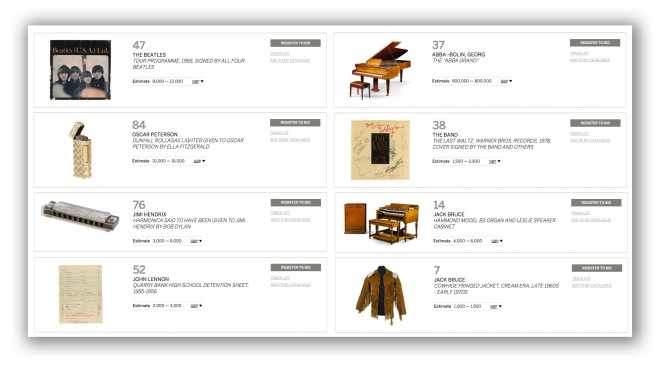IMAGES OF THE WEEK
From the upcoming (September 29th) Rock & Pop auction at Sotheby’s in London, these eight lots are my favourites. A spare £150,000 may get you Bob’s original “Hard Rain” lyrics… [From the family of Elisabeth (Lily) Djehizian, the first wife of Hugh Romney (“Wavy Gravy”). Lily met Romney whilst working as a waitress at the Gas Light and was closely associated with many of the artists working in Greenwich Village in the early 1960’s, most notably Lenny Bruce.] Click to enlarge – check out the great Beatles’ (U.S.A.) Ltd. typography.
WELL THIS RAISES THE GAME A LITTLE BIT
Spellbinding six-minute overview of the current state of Kendrick Lamar’s music on the Late Show with Stephen Colbert. Lamar makes most current music look dumb and pallid. It isn’t just the crack rhythm section or the compelling jittery shapes he throws as he sings, it’s the delivery and the timing. He romps through the mid-section with the fantastic beat of To Pimp a Butterfly’s “King Kunte” dissing musical frauds– “I can dig rappin’, but wait! a rapper with a ghost writer? tell me what happened!?“ The song relentlessly builds by moving up a semi-tone every chorus, the two bass players powering it on and on, before it morphs into a effects-driven jazzy end section with an amazing repeated vocal riff on “lovin’ you is complicated…” Staggering.
NOT STAGGERING
Is it just me, or is this as tuneless as I think? One of Apple’s new Apple Music adverts with Leon Bridges, or as he’s known in our house, Aloe Blacc without a decent song. The others aren’t much more convincing – I’m not sure Shamir or Flo Morrisey are doing anything not done better before.
BEST TELEPHONE TREE HOLD MUSIC THIS WEEK!
…and the winner is: Southern Electric, with the Miles Davis Quartet (Miles on trumpet, Red Garland on piano, Paul Chambers on bass and Philly Joe Jones on drums) playing “When I Fall in Love (it Will be Forever)”. It was on repeat and made the resulting 25-minute wait way more pleasant.
FROM MARK MYERS’ WSJ PIECE ON THE MAKING OF STEELY DAN’S “DEACON BLUE”
Strangely, Mr Christlieb is referred to as Pete…
Mr Fagen: “When everything was recorded – the rhythm section, the horns and the background vocals – Walter and I sat in the studio listening back and decided we needed a sax solo, someone to speak for the main character. We liked the sound of a tenor saxophonist who played in Johnny Carson’s Tonight Show band, a cat who blew like crazy when the show went to a commercial. He had this gutsy sound, but we didn’t know who it was.”
Mr Becker: “We had our producer Gary Katz ask around and he found out it was Pete Christlieb. Pete had invented any number of cool harmonic devices that made his playing sound unique. He just sounded like a take-charge soloist, a gunner.”
Pete Christlieb: “I went over to the studio one night after the Tonight Show finished taping at 6:30 p.m. When I listened on headphones to the track Tom [Scott] had arranged, there was just enough space for me to play a solo. As I listened, I realized Donald and Walter were using jazz chord changes, not the block chords of rock. This gave me a solid base for improvisation. They just told me to play what I felt. Hey, I’m a jazz musician, that’s what I do. So I listened again and recorded my first solo. We listened back and they said it was great. I recorded a second take and that’s the one they used. I was gone in a half-hour. The next thing I know I’m hearing myself in every airport bathroom in the world.”
EXTRA! FOR ALL YOU NIGHTHAWKS OUT THERE…
It’s Pete Christlieb’s sax on Tom Waits’ wonderful Nighthawks at the Diner. I found this piece on its recording, a Dan Daley interview with Bones Howe… “We started talking about where we could do an album that would have a live feel to it. We thought about clubs, but the well-known ones like the Troubadour were toilets in those days. Then I remembered that Barbra Streisand had made a record at the old Record Plant studios, when they were on 3rd Street near Cahuenga Boulevard. It’s a mall now. There was a room there that she got an entire orchestra into. Back in those days they would just roll the consoles around to where they needed them. So Herb and I said let’s see if we can put tables and chairs in there and get an audience in and record a show. I got Michael Melvoin on piano, and he was one of the greatest jazz arrangers ever; I had Jim Hughart on [upright] bass, Bill Goodwin on drums and Pete Christlieb on sax. It was a totally jazz rhythm section. Herb gave out tickets to all his friends, we set up a bar, put potato chips on the tables and we had a sell-out, two nights, two shows a night, July 30 and 31, 1975. I remember that the opening act was a stripper. Her name was Dewana and her husband was a taxi driver. So for her the band played bump-and-grind music –and there’s no jazz player who has never played a strip joint, so they knew exactly what to do. But it put the room in exactly the right mood. Then Waits came out and sang “Emotional Weather Report”. Then he turned around to face the band and read the classified section of the paper while they played. It was like Allen Ginsberg with a really, really good band.” From Tomwaitsfan.com












